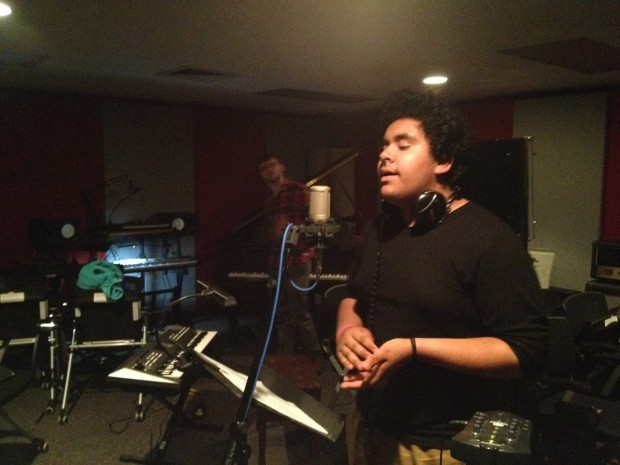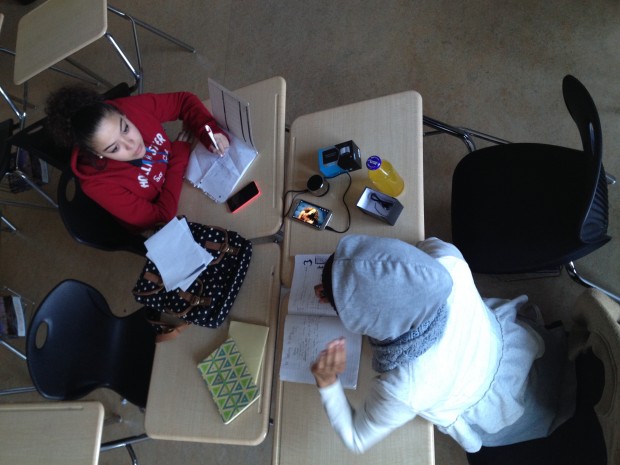
Inside the Aspiring Young Artists program, a six-week songwriting workshop for high schoolers
Across the street from the Kensington High School for the Creative and Performing Arts, through the rusted blue foundation of the Market-Frankford Line and past the opposing gravel-filled vacant lot, there are murals. On the left is a zoomed-in portrait of a hoodied black teen with the caption, curving around his head, “Trying to be a good person.” To the right, another face, this one anonymous, silhouetted with black paint. Inside the face is an assurance, or maybe even a plea. “Don’t worry I’m not gonna rob you.”
Ricky Strickler, a 27-year-old master’s student at Temple studying Urban Education, sees beyond this stereotype. An experienced worker in Philadelphia schools through programs like AmeriCorps and YouthBuild Philly, a charter school specifically for high school dropouts, he got a firsthand view of a school system that was both broke and failing to recognize its own students’ talents. “It was amazing to see how much incredible music talent was passing through that building, who had been pushed out or had left our regular high schools,” he says. “So that got me thinking about music and how it could be used pedagogically, in education.”
Before grad school, Strickler majored in business and wanted to pursue a job in the music industry. A drummer since age 12 and a member of a multiple bands growing up, it seemed the natural path. Until it wasn’t anymore. “Somewhere along the way, my last couple of years in college,” he says, “I got really interested in education in America and the inequalities that exist, specifically in inner cities.”
Strickler was still passionate about music; he just had to figure out how to combine this with his newfound interest in education. The result is the Aspiring Young Artists program, which piloted this year at KCAPA. Serving also as the capstone project for his Urban Education degree, the program is a six-week songwriting workshop that culminates with students taking their carefully crafted compositions to the studio and turning them into real, tangible songs.

Jesus Rivera | photo by Nnamdi Ejim | courtesy of AYA project
On a blustery Friday afternoon in February, KCAPA is nearly empty. Most of the school’s students have the day off, but six remain, choosing to stick around for the first official meeting of AYA. The school is built of sleek gray metal with large windows running along the front, looking very futuristic compared to the dilapidated buildings it surrounds. Its interior is lined with bricks.
Deliyah Carrasquillo, a 10th grade student with a thin face and arching eyebrows, is brainstorming basic song ideas in a room in the far corner of the school. She sits at a piano, flanked by music stands and a xylophone, while her mentor, Jameer Royal, samples an electro RnB beat, which will eventually become the foundation of the song “It Gets Better.”
Deliyah has never written a song before, and she’s shy at first, explaining to Royal, “I’m just trying to think of some words.” The beat echoes and bounces off the tiled linoleum floors and up through the high ceiling, as if taunting her to create a masterpiece of songwriting right away.
Royal, who is a singer-songwriter currently working on his first album, wears a black sweater, stylishly ripped jeans, and displays a scruffy beard. He paces around the room, his head slowly bobbing to the beat. “Give me one sentence about how you feel,” he suggests.
Deliyah doesn’t know, her long fingernails tapping against the top of the piano, a quiet percussion section to the looping music. Then, suddenly, the genesis of an idea hits like a flash of lightning that jolts her entire body.
“I know it gets better out here.”
Deliyah’s pink pen begins to scribble furiously, finally making contact with paper. The song then begins to grow organically as she thinks of more lines. “Baby keep your head up, there’s no fear.” “You don’t need to worry, there’s somebody.”
Now Deliyah is standing up, her wispy singing voice gaining strength with every syllable, one hand leaving her notebook and beginning to move up and down with the beat like a conductor, so that even her mentor can that see at this nascent stage the song is beginning to sprout its first blossoms. “Yesssssss! Get it!” he shouts.

Madeline Abizu-Vasquez (left) and Natasha Jovan (right) | photo by Nnamdi Ejim | courtesy of AYA project
Moments like this are exactly what Strickler is attempting to cultivate. “There’s a difficult transition that a lot of musicians come to between loving music, listening to music, and singing a lot of other people’s songs, and then beginning to write their own,” he explains.
Allowing the students to write their own original music – mentors are there only to shepherd the process, not force a specific genre or style upon the kids – has perhaps even a more significant social benefit, particularly in a school district like Philadelphia. Indeed, the very act of writing a song is a mini act of defiance, telling the world, There’s something on my mind, and I refuse to keep it to myself.
There’s power in this self-expression, as Strickler notes, “especially for students who more often than not get silenced by our school system, by our society, in a whole lot of ways.”
Meanwhile, in the cafeteria, a similar scene unfolds. Madeline Abizu-Vasquez sits at a far table next to the windows, past a Philly Pretzel box full of snacks. A mentor sits on either side of her, a dreadlocked man wearing glasses and massive over-ear headphones who gives off a calming, professorial vibe, and Natasha Jovan, a short woman with poofy hair and a squealing voice that sounds like it’s just taken a massive drag of helium.
Once again, the beat plays in the background. Madeline and Jovan talk structure, figuring out where lyrics should go, if one line is better for a verse or a chorus. It quickly becomes clear Madeline’s song is about a boy, and Jovan excitedly jokes, “Does he like you? Is he gonna hear it?”
Madeline laughs. Even in these lighthearted moments, a powerful relationship is beginning to form. Weeks later, Madeline reflects, “She helped me realize a lot of things that I didn’t realize about myself. Made me a better person. Made me feel how much music was important in my life.”
Jovan, who currently is a teacher but also writes and performs music, saw significant personal growth from Madeline over the course of the program. “I think that she got a better understanding of how to make a good song and I think that she became a lot more confident in her abilities as a singer and as a writer,” Jovan says.
Over time, Madeline began to open up and feel comfortable expressing herself, both to Jovan and the rest of the group. “It’s a great opportunity for self-expression and just to kind of help with someone’s creativity and their ability to storytell, and talk about themselves and just what share what they know or what they live in a very creative and non-conventional way,” Jovan says.
After the first session concludes, Strickler, looking simultaneously casual and professional in a gray Phillies sweatshirt alongside black slacks and dress shoes, gathers everyone in a room to recap the day. He asks the students how it was meeting their mentors and one girl quickly shares, turning to her mentor, “We’re like super twinsy cause we’re both Virgos.” When it’s Deliyah’s turn she adds, “We had so much in common. We was vibin’, we danced, were singing… Just started talking about life, things that hurt me.”

Ramsey Rodriguez (right) and his mentor, Jonathan (left) | photo by Nnamdi Ejim | courtesy of AYA project
In the years to come, Strickler hopes to maintain and expand AYA, not wanting it become a one-off project that only took place for his master’s degree. The skills the program teaches are too important.
Perhaps most importantly, Strickler has seen how the process of recording a song instills confidence in the students. Case in point: there were two students at the beginning of the program who refused to sing with the group and share their progress. By the third and fourth weeks, they felt comfortable to share, albeit nervously, with the group. And when it was time to record in April, they were “ready to go, not backing down.” Strickler believes this experience will have lasting effects on his his students for years to come. “Especially when you’re that age, confidence in any area can spill over,” he says.
For Madeline, the mere opportunity to record her own music resonated deeply with her. “Music helps me get through a lot of obstacle courses of life and it makes me realize a lot of things in life, like what’s happened to me and friends,” she says.
Even the mentors got something out of the program. “I’m thankful for the program because it helped me to utilize both of my talents and both of the things that I love, which are teaching and singing/songwriting,” says Jovan, who teaches at a school Monday through Friday. “It was really fun for me to be able to use my talents to help someone else and to help me stay on my toes, not only creatively but just being able to exercise my ability to teach others.”
Now that the inaugural AYA is finished, Strickler is working to establish an official non-profit and apply for grants so that the program can move into other schools.
“One thing about KCAPA is they are really wonderful, but they already have a great music program. Their choir is top notch,” he says. “I’d like to see this expand into schools that aren’t music magnets, schools where music programs have been hit harder by budget cuts.”
One day, he dreams of establishing a sort of community center, where he could host all sorts of classes under one roof, ranging from songwriting, to dance, to visual arts. But until then, Strickler is taking it slow, raising funds for the next group of Aspiring Young Artists, and working to bring the program to a second school, all while remembering the true heartbeat of the program: the songs.
It would be a lie to say the songs that the AYA students produced – recorded over two weeks in early April at a Temple studio – are flawless. Sometimes the notes drift out of tune, sometimes a bridge lasts way too long. But all six have in common a contagious feeling of passion. There’s something almost sacred about this music, physical proof of a beginning.
Much will change in these kids’ lives over time and some may never even record another song. But AYA has captured something profound in this six-song album, captured the power of a song.
For more information on the Aspiring Young Artists program, visit their website at aspiringyoungartists.com